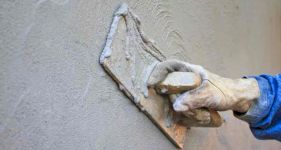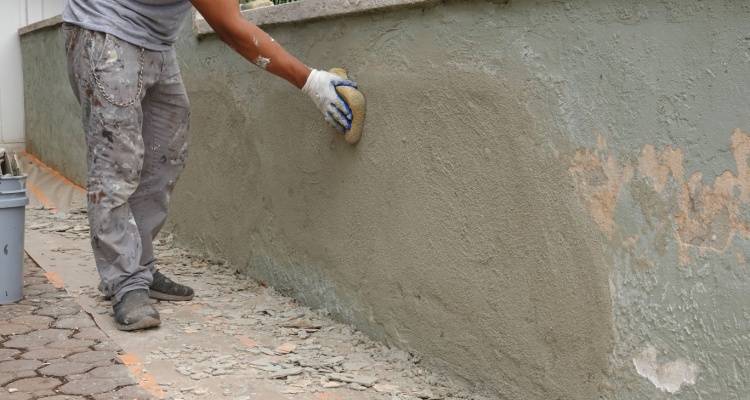Lime Rendering Costs
- Lime rendering costs are on average around £7,000
- Depending on the size of your property, it will take on average 5 days to complete
- A breakdown of pricing information for lime Rendering your property
- Additional costs which need to be considered
- How you make savings
- Information about building regulations and planning permission for lime Rendering
- The benefits of lime Rendering
Lime rendering is long-lasting. The material is breathable which means the risk of damp and humidity is low. It also has good adhesion and it’s very easy to apply and create a high-quality finish. Another benefit is that lime Render comes pre-coloured so there are no extra painting costs to consider.
Want to know how much it will cost?
This guide will help you find out more about lime Rendering so that you can make an informed decision about the materials you want to use. We supply the average costs of lime Rendering together with the other costs you’ll need to consider.
We can also connect you with lime render contractors in your area, which means you can get at least three jobs for the job.
Have a look through our guide and find out the costs of lime Rendering below!

£7000
Table of Contents
- How Much Does Lime Rendering Cost?
- Additional Costs
- Cost Factors of Lime Render
- Lime Rendering Options
- Cost of Lime Render Repair
- Rendering Guarantees
- Are There Ways I Can Reduce the Cost of Lime Rendering?
- How is Lime Rendering Applied?
- Planning Permission and Building Regulations
- Finding a Tradesman to do your Lime Rendering Work
- FAQs
How Much Does Lime Rendering Cost?
The lime Render costs shown above are average prices. The cost to lime render a house may change depending on where you are in the UK. Prices in London and the South of England are higher than in the North of England or Scotland.
Ot also depends on the size of the area you wish to have rendered, but on average, you'll pay between £30 to £50 per m2.
Lime Render Prices
| Type of House | M2 | Cost at £60 per M2 | Cost at £100 per M2 | Duration of Job |
|---|---|---|---|---|
| Terraced | 88m2 | £5280 | £8800 | 2 days |
| Semi-detached | 97m2 | £5820 | £9700 | 5 days |
| Detached | 149m2 | £8940 | £14900 | 8 days |
| Bungalow | 77m2 | £4620 | £7700 | 6 days |
Additional Costs
Scaffolding Installation
Most lime rendering jobs require the use of scaffolding. Scaffolding hire on average, is between £20 to £25 per m2. The cost of scaffolding for a week will cost between £200 and £800 depending on the size of your property and the amount of scaffolding you need to fit.
Skip Hire
You’ll need somewhere to get rid of your old rendering if you have it. The best solution is to hire a skip to get rid of the rubbish. A 6 Yard skip is ideal for building clearance. The cost is around £200 depending on where you live in the UK. London and the south of England will probably be more expensive.
Skip hire isn’t cheap so make sure when you hire that the skip is the right size. Your rendering contractor should be able to tell you what you’ll need.
Render Types
If you change your mind about lime render, here are details of other types you can choose.
- Sand and Cement Render
- Silicone and Acrylic Render
- Monocouche Render
- Cork Render
- Lime Render
- Pebbledash
- Polymer Render
Cost Factors of Lime Render
Removal of Old Render
If you already have render on your exterior wall, you will need to remove it before you can apply a new lime render unless you are going to apply external wall insulation. External wall insulation can usually go on top of old render, but your contractor will advise you on what option is best.
| Type of Property | Time Taken for Removal | Cost of Removal | Number of Trades People |
|---|---|---|---|
| Terraced House | 1 day | £1500 -£3000 | 1 |
| Semi-Detached House | 2 days | £3000 - £5000 | 1 |
| Detached House | 3 to 4 days | £5000 -£8000 | 2 |
Wall Insulation
If you don’t want to pay to remove your old rendering before you replace it with new rendering, or building regulations have stipulated that you need to improve your external wall insulation, then you might consider having wall insulation installed. It will cost more than having the render removed.
But you will get the advantage of an extra layer to your home. This will give you better heat retention, less risk of damp and reduced energy bills. Your home will be more energy efficient.
After installing insulation, the render will need to be lightweight. Lime render will be ideal. The price of wall insulation depends on the size of your property, but you can see from the chart below what the average cost is and how it compares with render removal.
| Property Size | Cost of Render Removal | Cost of Insulation | Price Difference |
|---|---|---|---|
| Terraced | £1500 - £3000 | £6000 - £7000 | £4500 - £4000 |
| Semi-Detached | £3000 - £5000 | £8000 - £9000 | £5000 - £4000 |
| Detached | £5000 - £8000 | £16,000 - £17000 | £11000 - £9000 |
Repairing Poor Brickwork
You should lay lime rendering over bricks that are in good condition. That means if your brickwork is damaged in any way, you’ll need a bricklayer to come and repair pointing or replace bricks.
The cheapest way to get bricks is to look for reclaimed bricks. Have a look online and you should be able to find a reclaim company close to where you live. Otherwise, new bricks are between 0.82p and 0.96p at a DIY outlet like Wickes. You can also buy handmade or glazed bricks. These will cost around 3p per brick new or around £1.20 reclaimed.
Repointing costs depend on the amount of work that needs doing. The average cost is between £23 and £47 an hour. Some brickwork experts work per M2 with prices ranging between £45 and £60 per M2.
Location
Where you live will influence the cost of applying lime rendering. Prices are always higher for materials and labour in London and the South East of England.
Lime Rendering Options
Here are some lime render options you can choose from:
QuickLime
QuickLime is calcium oxide, which is made by heating the Limestone to a high temperature. When you add water to the QuickLime mix, heat is released, and it is turned into calcium hydroxide.
It does need careful handling, though, because the chemical process can cause burns if it isn’t handled correctly. The end product is a Lime putty, which is used for rendering when mixed with sand.
PROS:
- ✔ Cheaper
CONS:
- ✖ Has to be handled with care
- ✖ Slower at setting
Hydrated Lime
Hydrated Lime is already mixed with calcium hydroxide. It comes as a powder ready to mix with water. There’s no risk of burns with this type of material, so it is the preferred rendering material for many contractors.
PROS:
- ✔ Less hazardous
- ✔ Permible
- ✔ More durable than quicklime
CONS:
- ✖ More expensive
Hydraulic Lime
Hydraulic lime sets in water and is used in exposed weather or hard conditions. It's created by burning limestone containing clay or by mixing in pozzolan materials.
PROS:
- ✔ Faster setting
- ✔ Durible in places with extreme weather conditions
CONS:
- ✖ Can't be set dry
Cost of Lime Render Repair
If your oldlLime render is damaged, then it may be cheaper to have it repaired rather than replaced. The most common repair you’ll need to address will be cracks in the rendering. These cracks will need to be repaired as soon as possible so that you don’t get water penetration which can cause mould and damp.
If you want to do it yourself, there are several crack/repair products available from DIY stores. Prices range from £5.00 to £30 depending on the amount of fix you buy. A tradesperson will charge between £15 to £30 per m2 to repair damaged render. The total cost will depend on the amount of rendering that needs fixing. An average patch repair can cost between £100 and £350.
Rendering Guarantees
Manufacturers tend to give a warranty or guarantee. But if you want to claim on the warranty the company will inspect to make sure that the rendering was applied correctly. Most guarantees are supplied for 10 years for lime render. Some companies also supply workmanship guarantees. Ask about this when you get a quote.
Are There Ways I Can Reduce the Cost of Lime Rendering?
If you are competent DIY enthusiast, you may want to do some of the work related to rendering your home yourself. It’s not recommended that you DIY lime rendering because it takes skill to get the mix right and apply the rendering correctly.
If you do want to try it, then make sure you get some tuition first. If you search on YouTube for lime rendering videos you will find several ‘How to’ videos that may help you.
Other ways to save money are to remove your old rendering yourself or help your contractor to save money on labour costs.
You will still have to pay out for scaffolding and/or skip hire and you may need to buy or hire tools. But if you have the time and the competence to do the work yourself then you will save between £5280 and £7700 depending on the size of your property.
How is Lime Rendering Applied?
Before any work is carried out the exterior wall will need to be prepared. You will need to remove any damaged or loose mortar from the brickwork or remove the old render. The wall will then need brushing to remove any dust, dirt, and debris.
Follow the instructions for adding water to the lime render mix. Apply a first coat of consolidation mortar render at 3mm and leave to dry for 24 hours. Apply 15mm coat of haired lime mortar and leave to dry for around 5 to 7 days. Apply 10mm layer of unhaired lime Mortar to finish.
Don’t forget to use gloves as lime render is caustic and can cause burns.
Planning Permission and Building Regulations
You will only need to apply for planning permission if you live in a listed building or a conservation area.
You will have to adhere to building regulations if you are planning to install new rendering or re-render more than 25% of an exterior wall. This is because exterior walls need to have a certain U-value for insulation. If your exterior walls don’t come up to the stipulated standard, then you will need to install insulation.
For the latest building regs information visit the appropriate department at your local council offices. Explain about your rendering project and they will advise you whether or not building regulations apply in your case.
If building regulations do apply the Council staff will inform you what you need to do, if there are any fees you need to pay and what forms you need to fill in.
Finding a Tradesman to do your Lime Rendering Work
If you log into our website and enter your postcode. After that tell us the type of tradesperson you need and answer some easy questions about the job. We’ll then get up to 3 tradespeople in your local area to contact you with quotes for lime rendering. It is advisable to obtain 3 quotes so that you can compare each one.
When you speak to the rendering specialists ask them if they have a website or photographs of work they have completed. Reading customer feedback will also help you to make a decision.
It’s also important to ask a few questions:
- First of all, find out if the contractor has any experience rendering properties. It may be a new company with a person fresh from training, so this is worth finding out because you may prefer someone with a lot of experience.
- Ask them if they make the arrangements for scaffolding and/or skip hire. If they don’t, you’ll need to organise this yourself.
- Also, ask the contractor if they possess third-party liability insurance. If they do it means that both the contractor and you are protected if any accidents occur.
- The insurance will take responsibility for any claims you make against the contractor in the case of any damage or injury that was caused whilst the rendering work was being carried out.
- You can also ask the contractor how long the job is expected to take and how many people will be involved in the work. If you want to save money by helping the contractor with some of the work, talk to them about this at the quotation stage.
- Finally, ask about any guarantees and warranties that come with the lime rendering work and make sure you are given the documents with the warranty details when the rendering work is complete.








